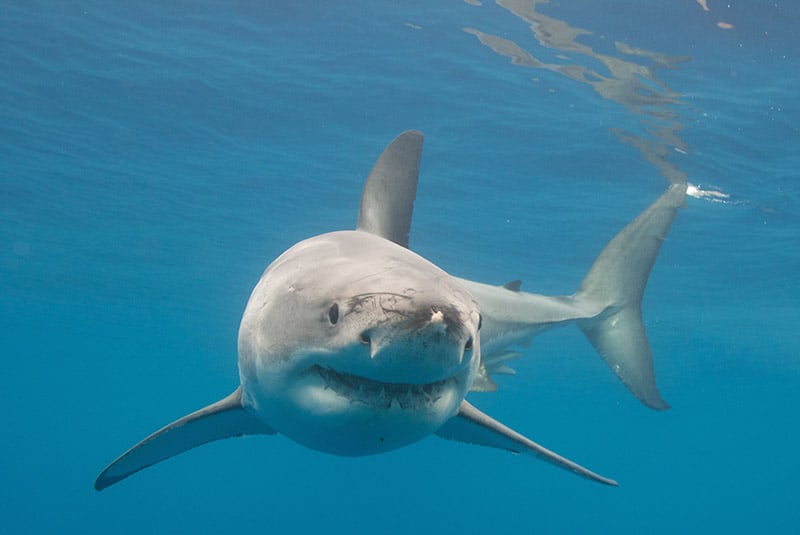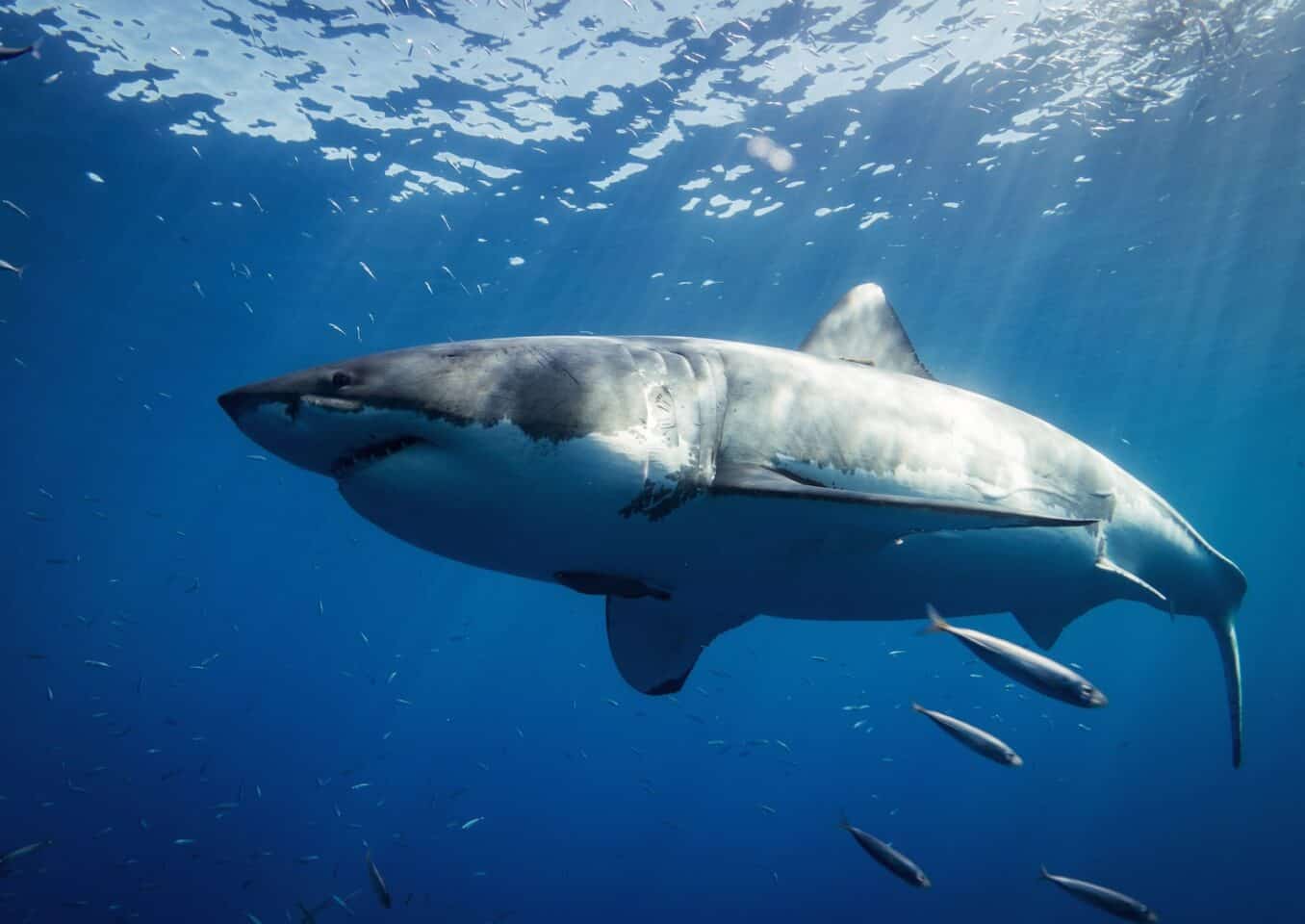The Great White Shark is a sentient and intelligent predator not to be underestimated as it can be potentially lethal, … but it also deserves our honor and respect!
Tthe Great White Shark, seldom seen by most, has been a little known and greatly feared creature inhabiting the worlds oceans. Throughout history the Great White Shark has obtained an almost mythical status, that of a monsterously fierce predator with a predisposition for attacking humans. Human fear, ignorance, indifference, and greed have led to a general misconception of this great animal and its needs, as well as its place in the balance of nature. Though difficult to study in its vast ocean home, dedicated individuals and organizations have learned quite a bit about this great creature over the last few decades.
Scientific Name: Carcharodon carcharias
| What’s in the name ? | ||
|---|---|---|
carcharos | means | “jagged” |
odon | means | “tooth” |
| Sharks in Captivity: | About the Great White Shark | |
|---|---|---|
Great White Sharks are usually only brought into captivity because they are sick or injured. Great White Sharks are not usually kept in captivity as they do not survive long. Here are two documented examples of these sharks successfully being put into a captive situation and then released.
Dr. Jungle, “This is the ONLY top predator that has not been kept in captivity or tamed by man!” Monterey Bay Aquarium: Caught in a commercial fishing net in August 2004, a young female Great White Shark was received by the Monterey Bay Aquarium and this is what they report about her. To learn more about this shark in captivity, visit the aquarium’s Electroreception The main topic of Mr. Martin’s article is electroreception, an acute sensitivity to electrical fields demonstrated by sharks and rays. In his article he discusses the unique opportunity “Sandy”, a healthy female Great White Shark in temporary captivity, provided to learn more about it. Here he tells us about her brief stay at the Aquarium. To learn more about “Sandy” at | Distribution: The Great White Shark is found throughout the world’s oceans, mostly in cool coastal waters. They can cover great distances and larger sharks have been seen journeying across the great ocean basins. Though generally solitary animals, they are occasionally seen traveling in pairs. Size: A very large species of shark, the Great White is the largest of the aggressive meat-eating sharks followed by the Tiger Shark. It is not known how large this shark can get, but the largest one recorded was 21′ long (6.4 m) and weighed 3312 kg. Newborn shark pups are about 4′ – 5′ (122 – 152 cm) long, with the smallest one measured at 47″ (119 cm). Most Great White Sharks average about 12 – 16′ (3.7-4.9 m) long with the larger ones being found in south Australia. Description: The Great White Shark has a torpedo-shaped body with a pointed snout, five gill slits, and a powerful crescent shaped tail which propels them through the water. They are grey on the top and white undermeath. Their three main fins, the dorsal on top and two pectoral fins, are used for balance. Four other minor fins; a small dorsal fin close to the tail, a pair of small pelvic fins, and a tiny anal fin, help with the way water flows over the sharks body. Their skeletons are made of cartilage rather than bone. Swimming: The Great White Shark is a graceful efficient swimmer. They will cruise along the bottom or close to the water’s surface, seldom swimming at midwater depths. They can also make fantastic leaps out of the water. Feeding: To obtain food they use primarily two senses; an extremely acute sense of smell, and an incredible keen ability, called electroreception, to sense electrical fields that are generated by all animals. These electrical fields are emitted by simple things such as skin coming in contact with the water, a contracted muscle, or the flow of blood into the water from a wound. There are no natural predators of the Great White Shark, they are at the top of the food chain. Great White Sharks are opportunistic feeders but they also eat carcasses they find, especially large whales, and will snack on fish caught on the lines and nets of fishermen. There are some critters they don’t like to eat! They don’t eat sea birds. They have been seen coming up beneath them and bouncing them up in the air like a ball, but they don’t eat them. They also don’t eat Sea Otters. Though they will often bite them, sometimes fatally, they have not yet been found in a shark’s belly. Breeding: | |

| White Sharks Need Protection | How to Help | |
|---|---|---|
Great White Sharks are globally threatened by human activities. The Great White Sharks are rare and it is believed they are decreasing in numbers. Threats to this shark include fisheries, accidental entrapment, and disruption of food.
| Dr. Jungle says, “Your consumer choices and how we interact with the Great White Shark are the keys to a future where our oceans are healthy, and rich with this shark as well as all the other ocean wildlife.” Ways in which you can make good choices: Buy sustainable seafoods! Get your FREE pocket guide here: “White Shark Diving “ Great White Shark diving opportunities are offered at a variety of locations including Dyer Island, South Africa, Isla de Guadalupe, Mexico, and the Farallon Islands from San Francisco. Some conservation efforts have been put into effect:
Under the new CITES regulations trade will be closely monitored, and may be banned altogether if white shark numbers keep declining. | |
Great White Shark and a Blonde, Carcharodon carcharias
This video is just a beautiful example of how proper posturing and touch will allow interaction with a Great White Shark. (not our title, just copied) These large fish often ignore humans, unless they are feeding and are “sampling” the weird person-fish out of curiosity. Great Whites often bite surfers near where sea lions live, mistaking them for prey, however the sharks do not pursue and eat a human since they don’t like how we taste. In a calm setting, a Great White can be interacted with if a person is calm, trained and it is NOT the shark’s feeding time!
Scientific Classification
| Kingdom: | Animalia |
| Phylum: | Actiniform |
| Class: | Elasmobranchii |
| Order: | Lamniformes |
| Family: | Lamnidae |
| Genus: | Carcharodon |
| Species: | carcharias |
- Beginner Fish – Saltwater fish for beginners
- Community Fish – Peaceful Saltwater fish
- Hardy Fish – Hardy Saltwater fish
Featured Image Credit: Gerald Schömbs, Unsplash
